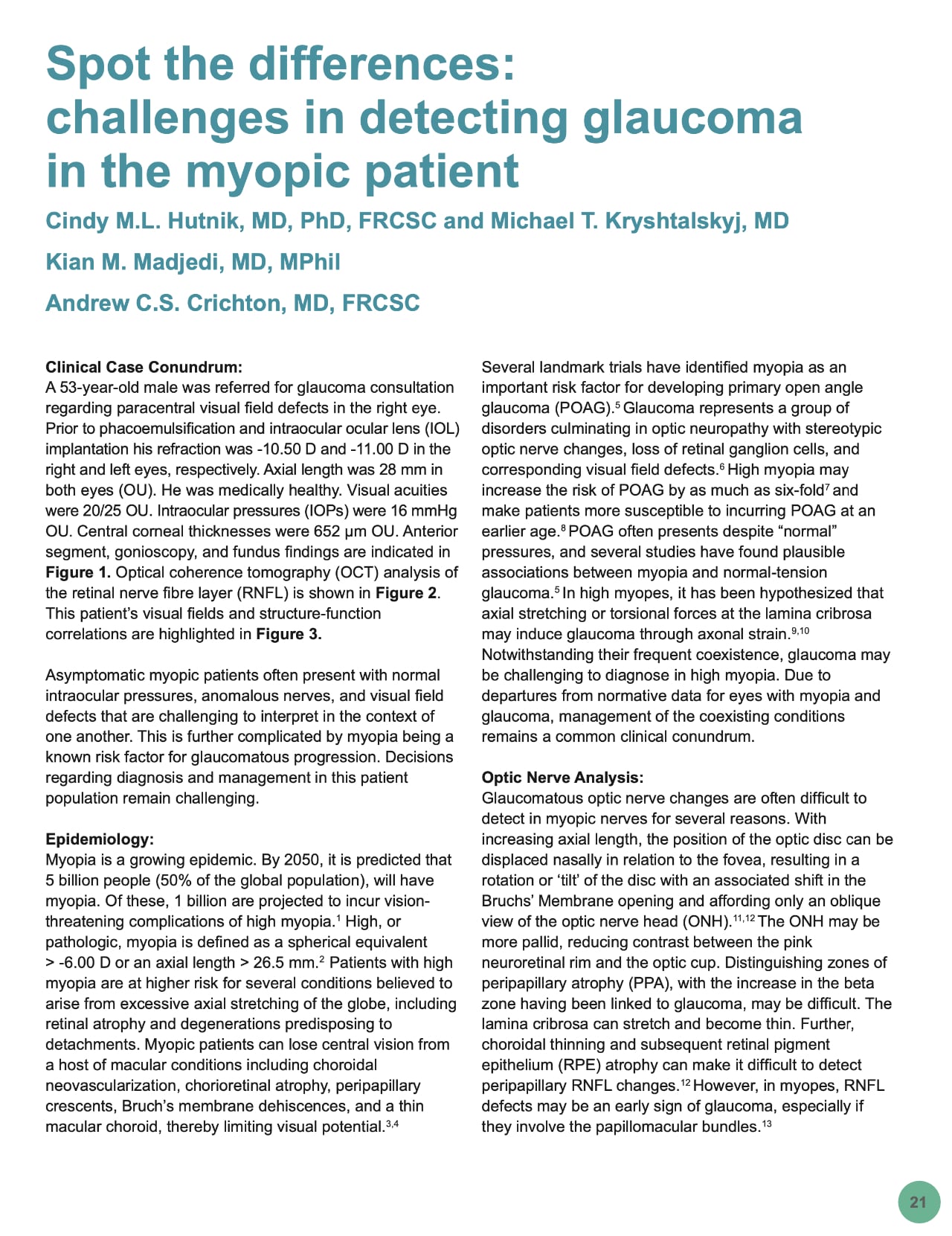Spot the differences: Challenges in detecting glaucoma in the myopic patient
DOI:
https://doi.org/10.58931/cect.2022.118References
Holden BA, Fricke TR, Wilson DA, et al. Global Prevalence of Myopia and High Myopia and Temporal Trends from 2000 through 2050. Ophthalmology. 2016;123(5):1036-1042. doi:10.1016/J.OPHTHA.2016.01.006 DOI: https://doi.org/10.1016/j.ophtha.2016.01.006
The impact of myopia and high myopia: report of the Joint World Health Organization–Brien Holden Vision Institute Global Scientific Meeting on Myopia, University of New South Wales, Sydney, Australia, 16–18 March 2015. Geneva: World Health Organization; 2.
Nishida Y, Fujiwara T, Imamura Y, Lima LH, Kurosaka D, Spaide RF. Choroidal thickness and visual acuity in highly myopic eyes. Retina. 2012;32(7):1229-1236. doi:10.1097/IAE.0B013E318242B990 DOI: https://doi.org/10.1097/IAE.0b013e318242b990
Ohno-Matsui K. Pathologic Myopia. Asia-Pacific J Ophthalmol (Philadelphia, Pa). 2016;5(6):415-423. doi:10.1097/APO.0000000000000230 DOI: https://doi.org/10.1097/APO.0000000000000230
Hsu CH, Chen RI, Lin SC. Myopia and glaucoma: sorting out the difference. Curr Opin Ophthalmol. 2015;26(2):90-95. doi:10.1097/ICU.0000000000000124 DOI: https://doi.org/10.1097/ICU.0000000000000124
Casson RJ, Chidlow G, Wood JPM, Crowston JG, Goldberg I. Definition of glaucoma: clinical and experimental concepts. Clin Experiment Ophthalmol. 2012;40(4):341-349. doi:10.1111/J.1442-9071.2012.02773.X DOI: https://doi.org/10.1111/j.1442-9071.2012.02773.x
Pan CW, Cheung CY, Aung T, et al. Differential associations of myopia with major age-related eye diseases: the Singapore Indian Eye Study. Ophthalmology. 2013;120(2):284-291. doi:10.1016/J.OPHTHA.2012.07.065 DOI: https://doi.org/10.1016/j.ophtha.2012.07.065
Shim SH, Sung KR, Kim JM, et al. The Prevalence of Open-Angle Glaucoma by Age in Myopia: The Korea National Health and Nutrition Examination Survey. Curr Eye Res. 2017;42(1):65-71. doi:10.3109/02713683.2016.1151053 DOI: https://doi.org/10.3109/02713683.2016.1151053
Lee KS, Lee JR, Kook MS. Optic disc torsion presenting as unilateral glaucomatous-appearing visual field defect in young myopic Korean eyes. Ophthalmology. 2014;121(5):1013-1019. doi:10.1016/J.OPHTHA.2013.11.014 DOI: https://doi.org/10.1016/j.ophtha.2013.11.014
Park HYL, Choi S Il, Choi JA, Park CK. Disc Torsion and Vertical Disc Tilt Are Related to Subfoveal Scleral Thickness in Open-Angle Glaucoma Patients With Myopia. Invest Ophthalmol Vis Sci. 2015;56(8):4927-4935. doi:10.1167/IOVS.14-15819 DOI: https://doi.org/10.1167/iovs.14-15819
Malik R, Belliveau AC, Sharpe GP, Shuba LM, Chauhan BC, Nicolela MT. Diagnostic Accuracy of Optical Coherence Tomography and Scanning Laser Tomography for Identifying Glaucoma in Myopic Eyes. Ophthalmology. 2016;123(6):1181-1189. doi:10.1016/J.OPHTHA.2016.01.052 DOI: https://doi.org/10.1016/j.ophtha.2016.01.052
Tan NYQ, Sng CCA, Jonas JB, Wong TY, Jansonius NM, Ang M. Glaucoma in myopia: diagnostic dilemmas. Br J Ophthalmol. 2019;103(10):1347-1355. doi:10.1136/BJOPHTHALMOL-2018-313530 DOI: https://doi.org/10.1136/bjophthalmol-2018-313530
Kimura Y, Hangai M, Morooka S, et al. Retinal Nerve Fiber Layer Defects in Highly Myopic Eyes with Early Glaucoma. Invest Ophthalmol Vis Sci. 2012;53(10):6472-6478. doi:10.1167/IOVS.12-10319 DOI: https://doi.org/10.1167/iovs.12-10319
Chang RT, Singh K. Myopia and glaucoma: diagnostic and therapeutic challenges. Curr Opin Ophthalmol. 2013;24(2):96-101. doi:10.1097/ICU.0B013E32835CEF31 DOI: https://doi.org/10.1097/ICU.0b013e32835cef31
Chong GT, Lee RK. Glaucoma versus red disease: imaging and glaucoma diagnosis. Curr Opin Ophthalmol. 2012;23(2):79-88. doi:10.1097/ICU.0B013E32834FF431 DOI: https://doi.org/10.1097/ICU.0b013e32834ff431
Park EA, Budenz DL, Lee RK, Chen TC. Red and Green Disease in Glaucoma. Atlas Opt Coherence Tomogr Glaucoma. Published online 2020:127-174. doi:10.1007/978-3-030-46792-0_8 DOI: https://doi.org/10.1007/978-3-030-46792-0_8
Tomography: Interpreting the RNFL Maps in Healthy Myopic Eyes. Invest Ophthalmol Vis Sci. 2012;53(11):7194-7200. doi:10.1167/IOVS.12-9726 DOI: https://doi.org/10.1167/iovs.12-9726
Wu Q, Chen Q, Lin B, et al. Relationships among retinal/choroidal thickness, retinal microvascular network and visual field in high myopia. Acta Ophthalmol. 2020;98(6):e709-e714. doi:10.1111/AOS.14372 DOI: https://doi.org/10.1111/aos.14372
Tay E, Seah SK, Chan SP, et al. Optic disk ovality as an index of tilt and its relationship to myopia and perimetry. Am J Ophthalmol. 2005;139(2):247-252. doi:10.1016/J.AJO.2004.08.076 DOI: https://doi.org/10.1016/j.ajo.2004.08.076
Aung T, Foster PJ, Seah SK, et al. Automated static perimetry: the influence of myopia and its method of correction. Ophthalmology. 2001;108(2):290-295. doi:10.1016/S0161-6420(00)00497-8 DOI: https://doi.org/10.1016/S0161-6420(00)00497-8
Hirooka K, Fujiwara A, Shiragami C, Baba T, Shiraga F. Relationship between progression of visual field damage and choroidal thickness in eyes with normal-tension glaucoma. Clin Experiment Ophthalmol. 2012;40(6):576-582. doi:10.1111/J.1442-9071.2012.02762.X DOI: https://doi.org/10.1111/j.1442-9071.2012.02762.x
Kim YK, Yoo BW, Jeoung JW, Kim HC, Kim HJ, Park KH. Glaucoma- Diagnostic Ability of Ganglion Cell-Inner Plexiform Layer Thickness Difference Across Temporal Raphe in Highly Myopic Eyes. Invest Ophthalmol Vis Sci. 2016;57(14):5856-5863. doi:10.1167/IOVS.16-20116 DOI: https://doi.org/10.1167/iovs.16-20116
Shoji T, Sato H, Ishida M, Takeuchi M, Chihara E. Assessment of Glaucomatous Changes in Subjects with High Myopia Using Spectral Domain Optical Coherence Tomography. Invest Ophthalmol Vis Sci. 2011;52(2):1098-1102. doi:10.1167/IOVS.10-5922 DOI: https://doi.org/10.1167/iovs.10-5922
Akashi A, Kanamori A, Ueda K, Inoue Y, Yamada Y, Nakamura M. The Ability of SD-OCT to Differentiate Early Glaucoma With High Myopia From Highly Myopic Controls and Nonhighly Myopic Controls. Invest Ophthalmol Vis Sci. 2015;56(11):6573-6580. doi:10.1167/IOVS.15-17635 DOI: https://doi.org/10.1167/iovs.15-17635
Biswas S, Lin C, Leung CKS. Evaluation of a Myopic Normative Database for Analysis of Retinal Nerve Fiber Layer Thickness. JAMA Ophthalmol. 2016;134(9):1032-1039. doi:10.1001/JAMAOPHTHALMOL.2016.2343 DOI: https://doi.org/10.1001/jamaophthalmol.2016.2343
Foo LL, Ng WY, Lim GYS, Tan TE, Ang M, Ting DSW. Artificial intelligence in myopia: current and future trends. Curr Opin Ophthalmol. 2021;32(5):413-424. doi:10.1097/ICU.0000000000000791 DOI: https://doi.org/10.1097/ICU.0000000000000791
Leite D, Campelos M, Fernandes A, et al. Machine Learning automatic assessment for glaucoma and myopia based on Corvis ST data. Procedia Comput Sci. 2022;196:454-460. doi:10.1016/J.PROCS.2021.12.036 DOI: https://doi.org/10.1016/j.procs.2021.12.036
Lee J, Kim YK, Jeoung JW, Ha A, Kim YW, Park KH. Machine learning classifiers-based prediction of normal-tension glaucoma progression in young myopic patients. Japanese J Ophthalmol 2019 641. 2019;64(1):68-76. doi:10.1007/S10384-019-00706-2 DOI: https://doi.org/10.1007/s10384-019-00706-2

Published
How to Cite
Issue
Section
License
Copyright (c) 2022 Canadian Eye Care Today

This work is licensed under a Creative Commons Attribution-NonCommercial-NoDerivatives 4.0 International License.
